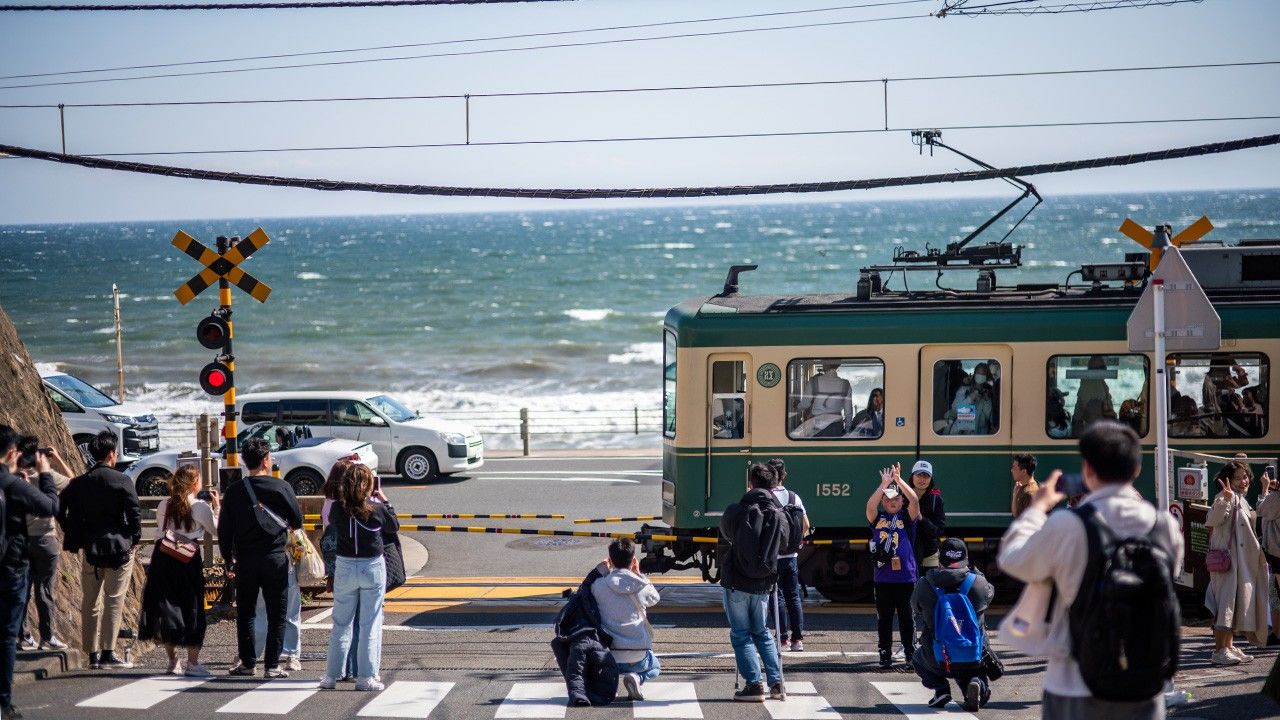
Japan’s Popular Tourist Destinations
An Otaku Pilgrimage Along the Enoden
Guide to Japan Manga Anime Travel Culture- English
- 日本語
- 简体字
- 繁體字
- Français
- Español
- العربية
- Русский
A Kanagawa Tour of Manga “Sacred Places”
In Japan, seichi junrei (visiting religious sacred places) is a practice dating back to the eighth century. Famously, it includes the world-famous henro pilgrimage in Shikoku. However, in the last 20 years, otaku fans have adopted this practice and started visiting locations that appear in their favorite manga and anime works.
When it comes to seichi junrei, the Enoshima Electric Railway (commonly abbreviated as Enoden) is one of the more popular destinations near Tokyo for otaku. First opened in 1902, the single-track Enoden is only 10 kilometers long, but the picturesque Kanagawa Prefecture region between Fujisawa and Kamakura stations that the train passes through is peppered with places that appear time and again in manga and anime.
In this article, I focus on the 4.2-kilometer stretch between Kamakura Kōkōmae and Yuigahama stations. By train, it only takes 17 minutes, but it’s rewarding to cover much of the distance on foot.
Kamakura Kōkōmae
You can reach Kamakura Kōkōmae, our starting station, from either Fujisawa or Kamakura. However, before boarding one of the Enoden’s signature green-and-yellow trains, hardcore fans of Suramu danku (Slam Dunk, serialized in 1990–96) may prefer beginning at Fujisawa in order to check out the futuristic-looking Akibadai Cultural Gymnasium where Shōhoku High School, the protagonists’ team, faces prefectural champion Kainan to win a spot at the national high-school tournament.
The Enoden’s central portion is sandwiched between the hilly residential area and the Pacific shoreline, but Kamakura Kōkōmae is the lone station from whose platform you can enjoy a breathtaking view of the sea and the open sky endlessly stretching before your eyes. When you add the station’s old-fashioned wooden structure, it makes for a unique atmosphere.
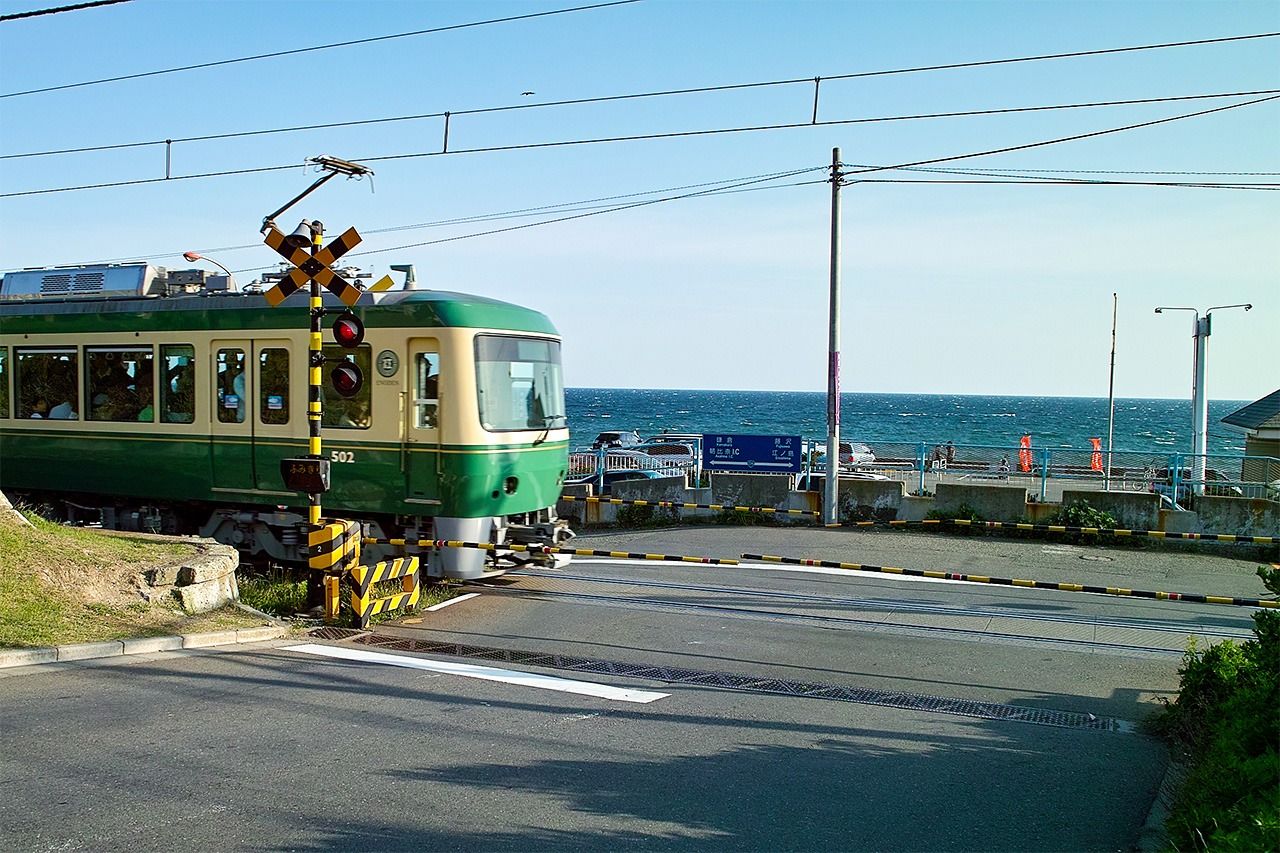
The famed railway crossing near Kamakura Kōkōmae Station. (© Gianni Simone)
More importantly for manga and anime fans, this is by far the most famous spot along the Enoden because the surrounding area is connected to Slam Dunk. You only have to walk east to the railroad crossing down the road to instantly recognize the TV anime’s opening sequence. In recent years, this spot has attracted scores of otaku tourists. Just be careful not to be run down by a car.
Follow that road uphill to reach the entrance to Kamakura High School, the institution from which the station derives its name. Please refrain from wandering inside the school grounds, though—this is a school where education is taking place!
Though Kamakura Kōkōmae Station is forever associated with Slam Dunk, this place appears in many other manga works including the yuri series Aoi hana (Sweet Blue Flowers, 2004–13), the 2012 fishing- and youth-themed Tsuritama, and Umimachi Diary (2006–18). The opening sequence in the 2014 televised anime version of Hanayamata (2011–18), meanwhile, is practically identical to that in Slam Dunk, while in the 2012 anime series Tari Tari, the residential area behind the station became the location for the route followed by the students when commuting to the fictional Shirahamazaka High School.
A short flight of stairs across the road takes us to a long, narrow beach. I recommend walking east two stops to Inamuragasaki Station (2 kilometers) and enjoying the sea breeze. From the beach vantage point near Cape Inamuragasaki, Enoshima stands out on the right, while on a clear day, we can see Mount Fuji along with the Izu and Miura peninsulas and even as far as the island of Ōshima to the south.
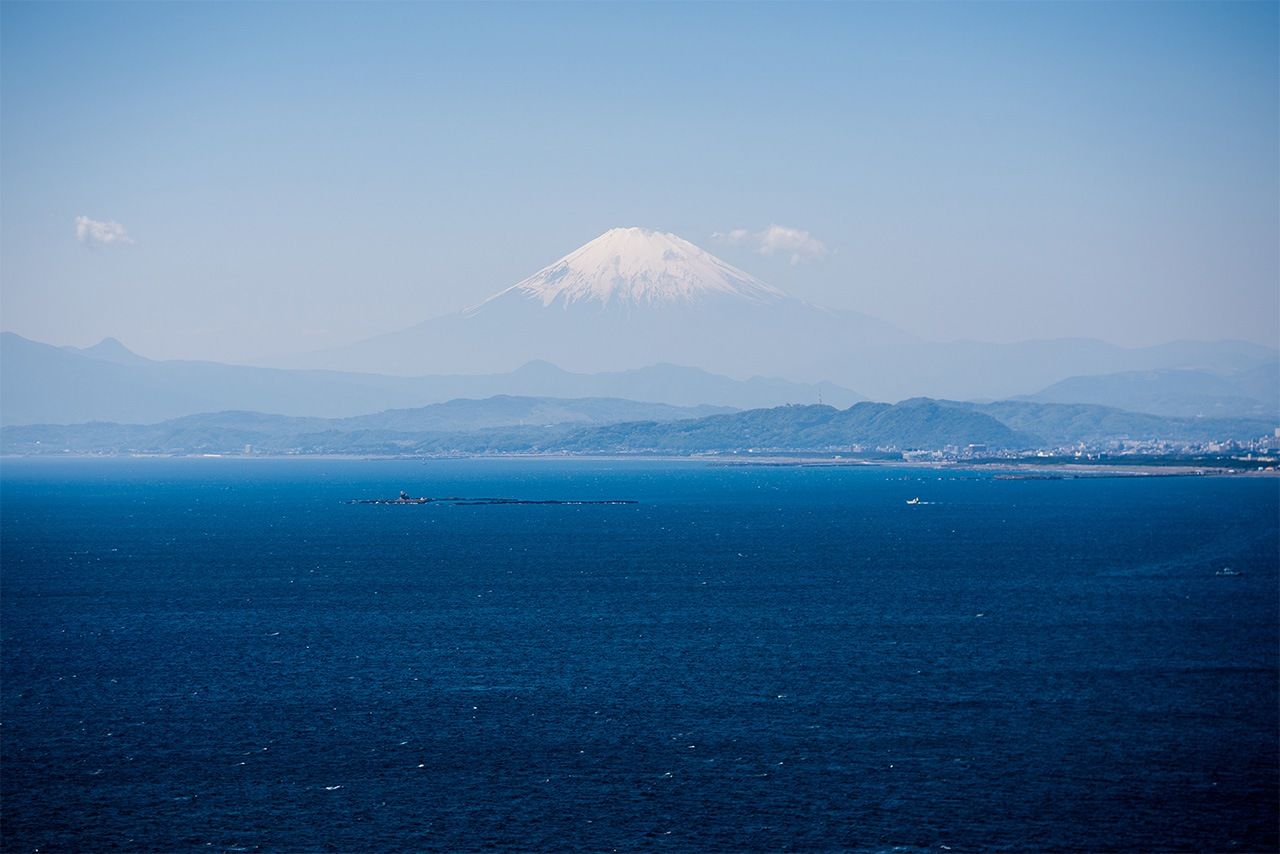
A view of Mount Fuji from the beach. (© Benjamin Parks)
This beach, of course, plays an important part in many anime and manga, including Umimachi Diary in particular, as well as Seishun buta yarō (Rascal Does Not Dream of Bunny Girl Senpai, released as light novels since 2014, manga since 2015, and anime in late 2018), especially during romantic scenes or when the characters need a secluded place to share their innermost feelings.
The sea here is quite rough and swimming is prohibited. On the other hand, this beach is a popular surfing spot and many people can be seen riding the waves, especially on the weekend.
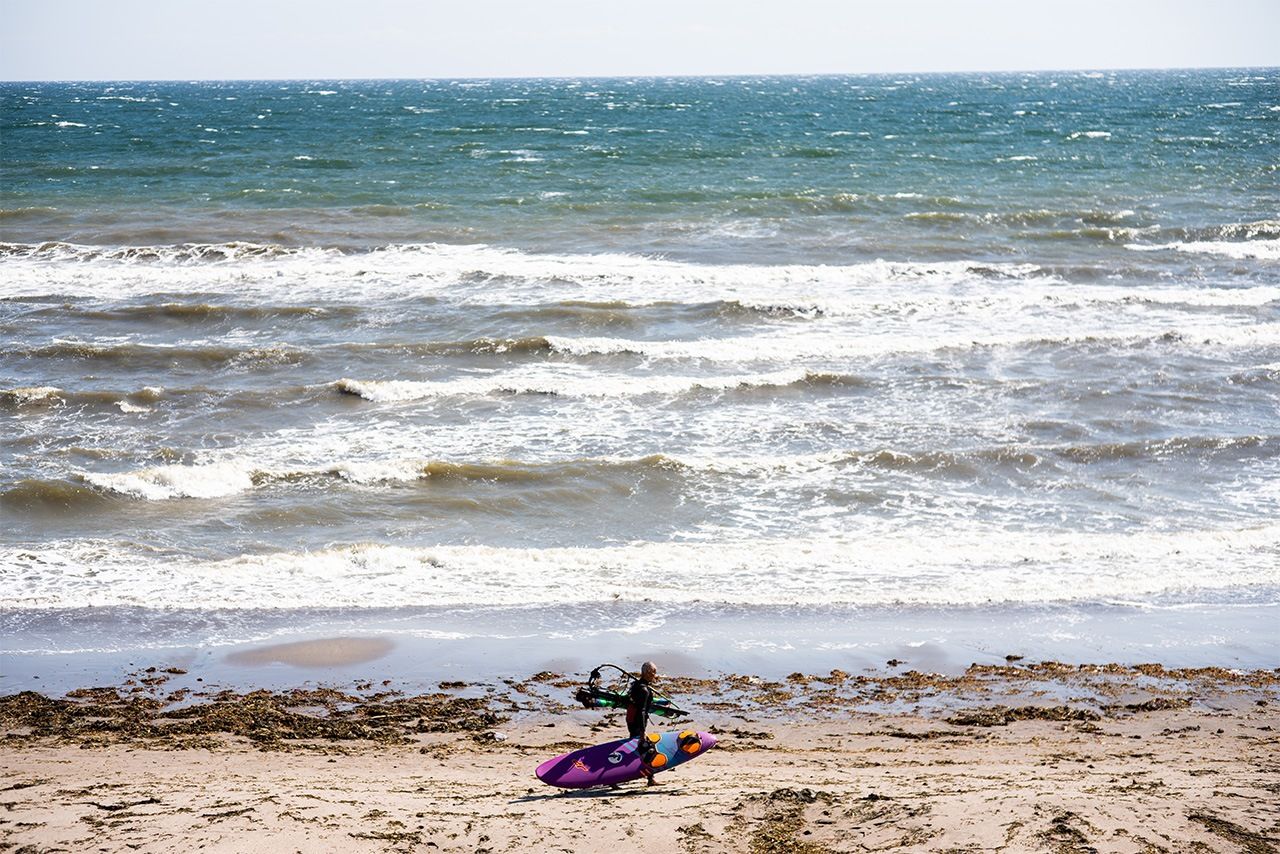
A surfer at Shichirigahama Beach. (© Benjamin Parks)
Shichirigahama
Rascal fans are advised to check out Shichirigahama Station, because it is on this platform that the embarrassed boy student Azusagawa Sakuta waits for the train with Sakurajima Mai, his cute schoolmate who suffers from what the work terms “Adolescence Syndrome.” Near the station is also located Shichirigahama High School (called Minegahara in the anime).
Before reaching Inamuragasaki Station, the train goes inland, but we recommend a detour to Cape Inamuragasaki, another scenic spot well worth visiting, particularly at sunset. This place is also featured in several works, including Shigatsu wa kimi no uso (Your Lie in April, serialized in its original manga form in 2011–15) and Minami Kamakura Kōko joshi jitensha-bu (Minami Kamakura High School Girls Cycling Club, serialized as a manga since 2011). Many people come here to view the sun setting behind Enoshima and Mount Fuji.

Enoshima viewed from Koshigoe Beach. (© Benjamin Parks)
Gokurakuji
At Inamuragasaki, we take the train uphill to the next station, Gokurakuji. Looking at the trains that these days often run at full capacity, it is hard to imagine that in the mid-1960s, the company considered closing the line after increasing motorization had resulted in a sharp decrease in ridership. In the end, the Enoden was saved by Oretachi no asa (Our Morning), a TV drama that began airing in October 1976 on Nippon Television. Big crowds of fans flocked to the area around Gokurakuji Station, where the main characters live, and rescued the ailing railway.
To be fair, Gokurakuji has much more to offer to curious travelers. Indeed, this small, quiet area has beautiful temples and is a favorite destination for flower lovers in spring and summer. The station building itself, with its cherry trees and the bright-red pillarlike mailbox that stands in front, is picture-perfect. However, it is hard to keep all those films and anime out of our minds, and just a look at the station is enough to be reminded of the 2002–5 Erufen rīto (Elfen Lied), Umimachi Diary, and Minami Kamakura High School Girls Cycling Club.
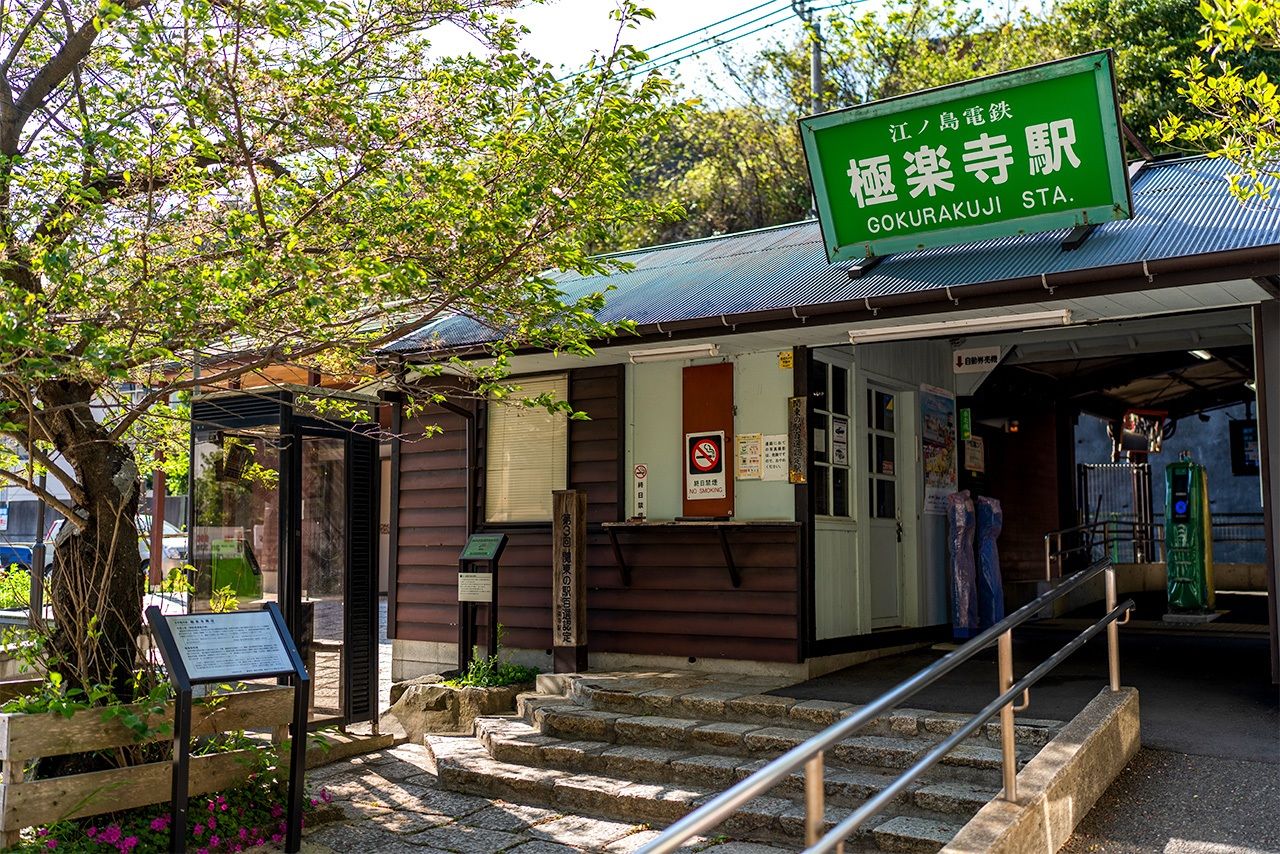
Gokurakuji Station. (© Benjamin Parks)
Gokurakuji, the Buddhist temple to the northwest from the station that provides its name, was founded in 1259 by Hōjō Shigetoki, a member of the most powerful political clan of the Kamakura period (1185–1333), and has been rebuilt many times since. Heading northeast from the station exit, we arrive at a red traditional bridge that on one side overlooks the station while on the other side offering a view of Gokurakudō, the only tunnel on this line.
This is yet another hot spot, but not many people know that it even appears in one of Kurosawa Akira’s best films, the 1963 Tengoku to jigoku (High and Low), the story of a child who is kidnapped for ransom. After the boy is released, he is shown around by the police and remembers this particular tunnel.
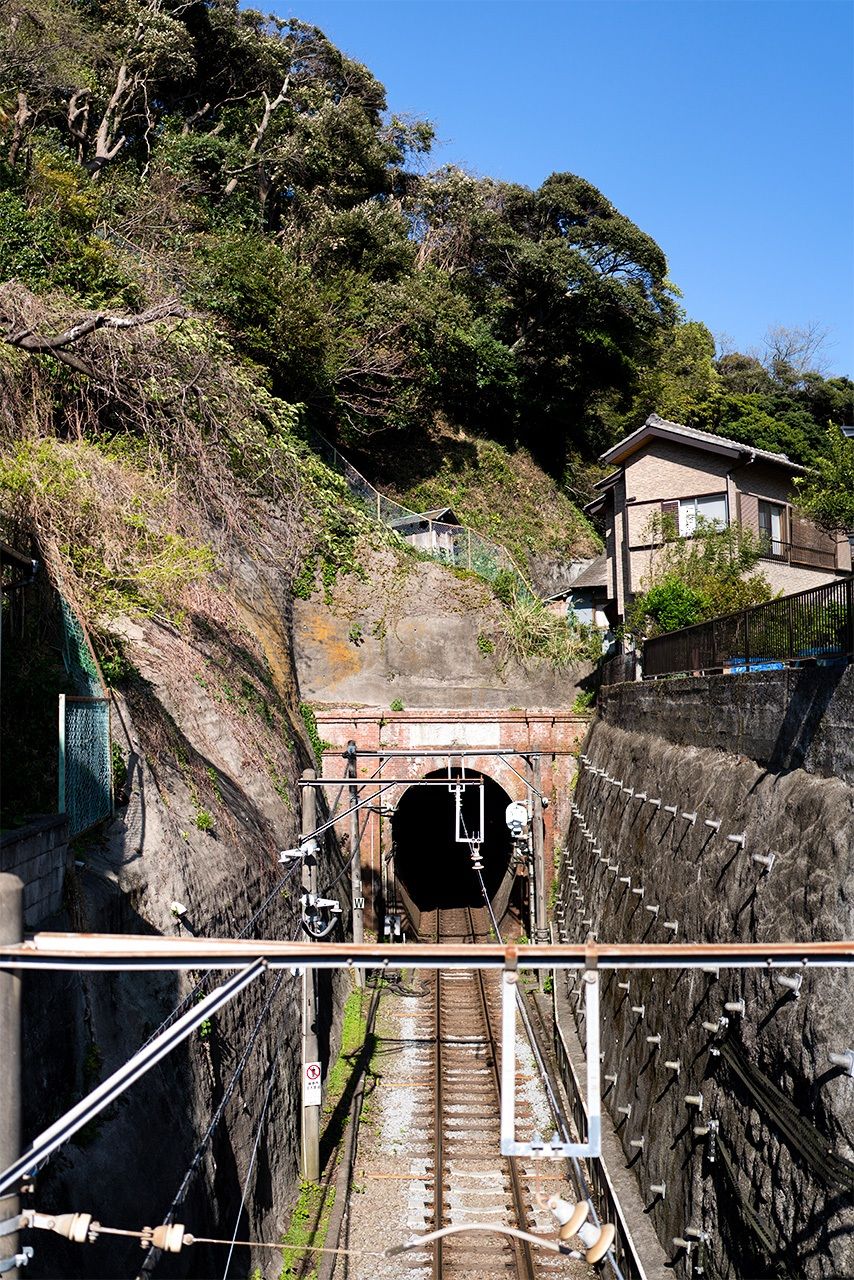
The tunnel near Gokurakuji also appeared in a Kurosawa film. (© Benjamin Parks)
From the bridge, let’s take the road heading uphill to the east. A few minutes later, we reach a long flight of stairs heading back up the hill on the right side of the road. We are now entering Elfen Lied territory.
The stairs lead to Jōjuin, a place that is shown frequently throughout the saga as it is one of several important and magnificent Buddhist temples where many of the events in Elfen Lied unfold. This series is by far the heaviest of the stories covered in this article, being famous for its dark mood and graphic violence. However, though Jōjuin’s cemetery is the site of a major and brutal confrontation, the place itself is far from scary.
Located at the peak of 108 stairs, Jōjuin was called a “watchtower temple’’ because it was built on the top of the hill, where it served as a citadel for the defense of Kamakura. In 1333, for instance, a fierce battle took place here between Nitta Yoshisada and the shogunal forces that defended Kamakura. Today the slope is completely safe and peaceful, offering a wonderful view of the ocean and Yuigahama Beach to the east.
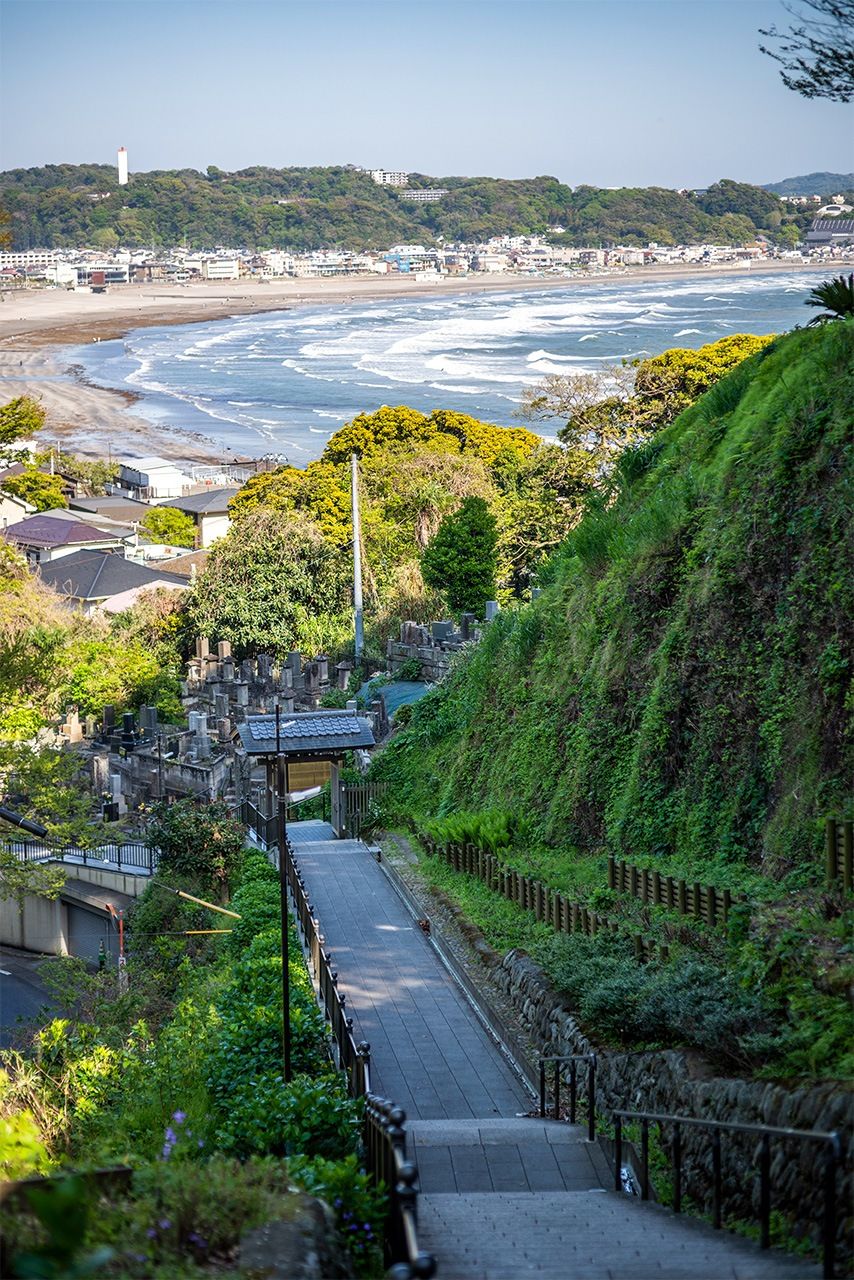
Yuigahama seen from the top of the stairs to Jōjuin. (© Benjamin Parks)
Heading along the same road to the east and turning left to travel away from the ocean at the next intersection, we reach Goryō Shrine, a very popular hydrangea flower-viewing spot and a location that figures in some of the above-mentioned works. There is a small railroad crossing just in front of the main entrance, and if we stand just inside the shrine grounds, we can take a beautiful photo of the torii gate, the row of hydrangea trees, and the passing Enoden train.
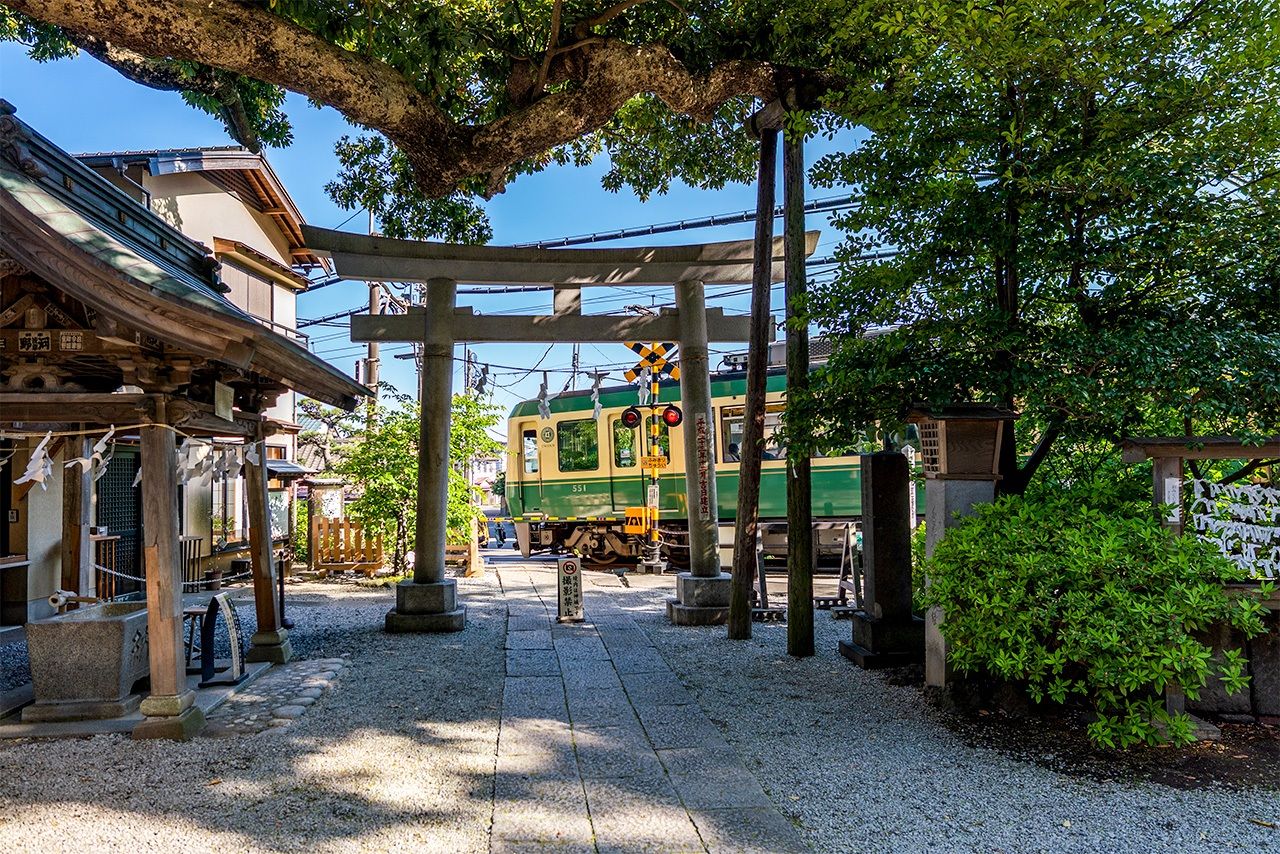
An Enoden train passes the torii of Goryō Shrine. (© Benjamin Parks)
Yuigahama
Our last stop, Yuigahama, lies to the south of the Kamakura Museum of Literature. This stylish, grand Western building was built in 1936 as a villa of Maeda Toshinari, a descendant of the lord of the Kaga domain (now Ishikawa Prefecture) in the Edo period, and has been used as a model for both Fujigaya Girls’ Academy, the high school featured in Sweet Blue Flowers, and the house of the main character in Tari Tari. Literary treasures apart, the museum—unfortunately closed to the public for reconstruction through March 2027—is also known for its beautiful rose garden.
If you plan to spend the night in the area, you can book a room at the Kamakura Wakamiya hotel, which is featured in Sūpā Kabu (Super Cub), a 2016–21 serial web novel later released in book, manga, and anime form, when the motorbike-crazy high school girls come to Kamakura on a class trip.
From the hotel, Yuigahama Beach is just a short walk away. This spot is a pivotal location in the Elfen Lied universe and the site of multiple important events, being for instance a spot where some of the characters used to play during the summer holidays when they were kids.
If the place makes you feel blue, there is nothing better to drive melancholy away than to listen to the Japanese alternative rock band Asian Kung-Fu Generation’s 2008 album Surf Bungaku Kamakura, in which each track is named after an Enoden station.
By the way, if you plan to frequently hop on and off the train during your visit, you should buy a one-day pass ticket for ¥800. And if possible, it’s best to avoid the weekends and holidays, when the Enoden is packed with tourists.
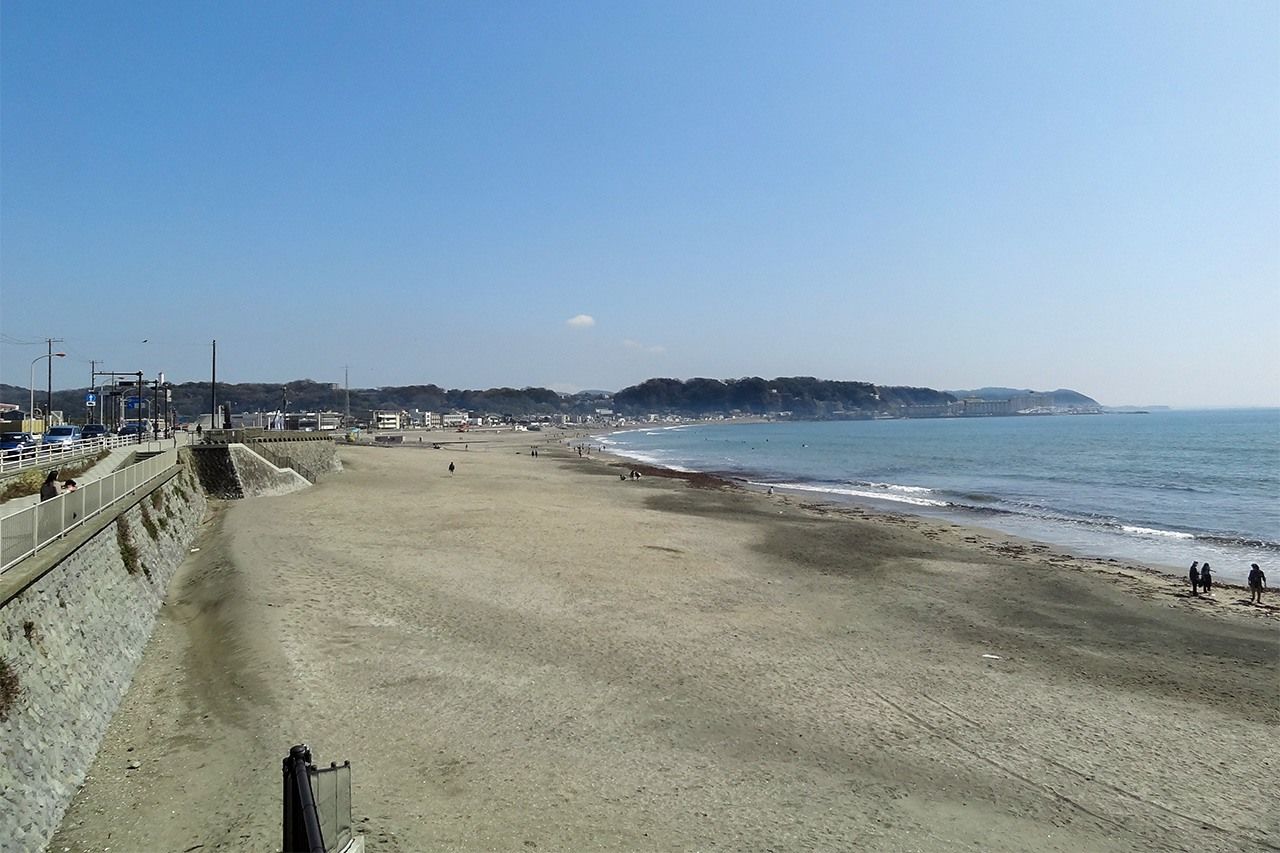
Minegahara Beach near Kamakura Kōkōmae Station. (© Gianni Simone)
(Originally published in English. Banner photo: An Enoden train passes the celebrated railway crossing near Kamakura Kōkōmae. © Benjamin Parks.)
tourism otaku manga anime Kamakura Slam Dunk Enoden Kanagawa Prefecture slam dunk